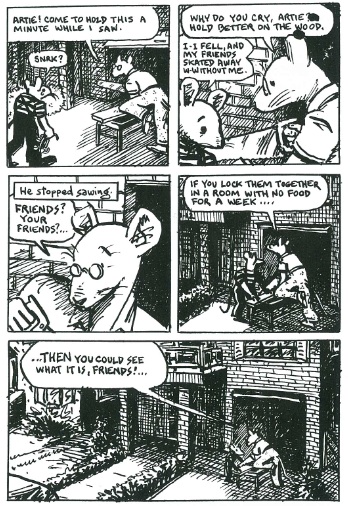Art Spiegelman’s graphic novel ‘Maus’ is the story of his parents Vladek and Anja Spiegelman and their survival during the Holocaust. Written over a thirteen-year period, the books (‘Maus I’ and ‘Maus II’) tell the story of Spiegelman’s attempts to learn about his father and mother’s experiences as Jews during the Holocaust and later as survivors in the United States. ‘Maus’ also documents Spiegelman’s difficult relationship with his father, his own search for understanding as a survivor of this relationship, and his artistic journey in creating the work. ‘Maus’ won the Pulitzer Prize for Fiction in 1992.
The historical content is based on dialogues between Spiegelman and his father, Vladek, over many years. Spiegelman uses animal heads with human bodies to portray characters: Jews are mice, Germans are cats, Poles are pigs, Americans are dogs, Frenchmen are frogs, Swedes are reindeer. While the subjects treated in the books are serious, there is also humor. The setting moves from Rego Park, New York, to various cities and towns in Poland, to a resort in the Catskill Mountains, to Germany, to Florida to Sweden. This device helps Spiegelman tell the larger story of the Holocaust with the authority of a survivor’s memories while at the same time telling the story of his family’s history and relationships during and after World War II.
Born in 1948 in Stockholm, Sweden, Art Spiegelman is a naturalized U.S. citizen. While growing up, Spiegelman lived with his parents in Rego Park in the Queens section of New York City. From 1966 to 1989 he worked for Topps Chewing Gum, Inc. illustrating trading cards and stickers including the Garbage Pail Kids series. He has written many comix (underground comics), worked as a New Yorker staff artist and writer, and been a lecturer and teacher at various times in his career. His work has been the subject of special museum and gallery exhibits both in the U.S. and abroad. Spiegelman is especially noted for his work as the co-founder and editor of the comix periodical Raw. Mr. Spiegelman is currently working on the story and the sets for an opera. His newest graphic novel, ‘In the Shadow of No Towers’, a reflection of the tragedy of September 11, was published in September 2004.
Maus – Initial Perceptions
- Using a post-it note, use three adjectives that initially come to mind when viewing the front cover of the graphic novel.
- What does the front cover reveal about the tone of the book? How are the characters depicted and what is the effect on the viewer?
Maus – Preface
Spiegelman begins his novel with an interaction between the young Artie and his father Vladek, where Artie questions the loyalty of friends.
- What is the purpose and function of this preface?
- How does this opening initially position Vladek (attitude, beliefs, ideals and history)?
- What does it revel about his relationship with his son?
Nazism – Ideals, Beliefs and Vision
Nazism, or National Socialism is a variety of fascism that incorporates biological racism and antisemitism. It was the ideology of the Nazi Party in Germany and related movements elsewhere. Nazism developed from the influences of pan-Germanism, the far-right Völkisch German nationalist movement and the anti-communist paramilitary culture which fought against the communists in post-World War I Germany. It was designed to draw workers away from communism and into völkisch nationalism.
Major elements of Nazism have been described as far-right, such as allowing domination of society by people deemed racially superior, while purging society of people declared inferior, who were said to be a threat to national survival. Both the Nazi Party and the Nazi-led state were organized under the Führer principle (“leader principle”), a pyramidal structure with the Führer – Adolf Hitler – at the top, who appointed subordinate leaders for all branches of the party and the state and whose orders had the force of law.
Nazism claimed that an Aryan master race was superior to all other races. To maintain what it regarded as the purity and strength of the Aryan race, Nazis sought to exterminate Jews and Romani, and the physically and mentally disabled. Other ethnic and social groups deemed “degenerate” or ‘inferior’ received exclusionary treatment, including homosexuals, blacks, Jehovah’s Witnesses, slaves and political opponents.
Located in the hyperlinks below is the opening of scenes of from the Nazi propaganda film, ‘The Triumph of Will’, and footage from an infamous Adolf Hitler speech.
- What was Hitler’s appeal to the masses?
- What aspirations did he hold for the German nation and how might this have served as an incentive for them to support his ideology
What was the world’s response to this type of propaganda you might ask? Well, our friend Walt Disney had his say. This is Donal Duck starring in ‘Der Fuehrer’s Face’, (1943) – I think you’ll enjoy this – click the hyperlink below.


